If you purchase an independently reviewed item through our site, we earn an affiliate commission. Read our affiliate disclosure.
Quick Overview
This article serves as a comprehensive guide to choosing the best honey extractors for beekeepers. Honey extractors are crucial in the beekeeping process, enabling the extraction of honey from the comb using centrifugal force.
This guide compares tangential and radial extractors, explaining the difference in how frames are loaded and spun, with tangential being more labor-intensive and radial offering more efficiency for commercial operations. It also contrasts manual versus electric extractors, detailing the advantages of each type based on operation size and power availability.
There are various honey extractor models available, that cater to different needs and budgets, ensuring beekeepers can make an informed decision. Regardless of the type, a good honey extractor is an investment in the quality and efficiency of honey production. You should carefully consider each extractor’s features and match them to the specific needs of the beekeeping operation before making a purchase.
Top Honey Extractor Picks
| Product Name | Type | Material | Feature | Link |
|---|---|---|---|---|
| VIVO BEE-V004E | Electric | Stainless Steel | 4-frame capacity | VIVO BEE-V004E |
| Hardin HE3MOT | Electric | Stainless Steel | 3-frame capacity | Hardin HE3MOT |
| VEVOR Stainless Steel 4-Frame Electric Honey Extractor | Electric | Stainless Steel | 4-frame capacity | VEVOR 4-Frame Extractor |
About Honey Extractors
Honey extractors are simple mechanical devices that extract honey from honeycombs. They use centrifugal force in a drum or container with frame baskets. This is where the honey is flung out and the combs are spun. Extracting is one of the final steps in the beekeeping process, and it is where you reap the benefits of your efforts.
There are numerous advantages to using honey extractors that should not be overlooked. Its main advantage is that it keeps the combs intact so that the bees can reuse them to make more honey. There are two types of extractors: radial and tangential. The primary distinction between them is how the frames are held within the basket. These types can either be powered manually or electrically.
With so many honey extractor brands on the market, you’ll never be short of options if you’re thinking about purchasing one. So, let us assist you in making that decision with our hand-picked list of the best honey extractors on the market today. Let’s take a look at them.
Overview of the Best Honey Extractors
11. VINGLI Upgraded 4-Frame Manual Honey Extractor
The Vingli Upgraded 4 Frame Honey Extractor is made using stainless steel and is manually cranked. It has its cranking mechanism and gearing installed at the top, externally. This ensures that the drum of the extractor does not have items in it that would contaminate or lower the quality of honey. This extractor comes in a silver color and has 3 legs holding up the drum. It also has a honey valve installed on the side. The legs are adjustable in height depending on your preference and the honey collection container you are using. They raise the height of the extractor from 40.6 inches to 47.3 inches at best. This extractor is great for both small and large beekeeping operations.
The design and installation of the cranking mechanism of this extractor are well done. The crank and gearing are made using strong metal that does not break even with vigorous craning. Adequate bearing is provided on the craning mechanism as well as alignment of the shafts and gears for efficient use of your energy. The crank handle is easy to use and shaped for great grip in your hand. Installation of the cranking mechanism is on a reinforced bar featuring the Vingli branding on it. The cover of the extractor is made using Plexiglass. It allows you to see beehive frames in the extractor drum so you know when the extraction is complete.
The adjustable height of the drum using its legs gives you clearance for your honey container under this extractor’s drum. You get a clearance of between 16.3 inches at minimum to 23 inches at maximum. This manual honey extractor is made using strong and durable stainless steel. It is safe to use with honey for human consumption.
On the downside, sturdiness can be an issue with this extractor. It may wobble and shake so much in operation that nuts, bolts, and other parts come loose.
Check Price
10. Little Giant Farm & Ag EXT2SS Stainless Steel Honey Extractor
If you are a more experienced beekeeper then you can never go wrong with the Little Giant Farm & Ag Stainless Steel Honey Extractor. It is a tangential extractor that is well-pleasing thanks to its amazing inner and exterior features. It has a clear plexiglass lid so you can monitor progress, and its overall build is sturdy and durable. What particularly intrigues me about this stainless steel extractor is the fact that it is a capable performer that is highly efficient.
Click here to read our full review of the Little Giant Farm & Ag EXT2SS Stainless Steel Honey Extractor.
Some beginners might find it frustrating to use this honey extractor but over time, with practice, it should become easier to use. This is due to the fact that it does not come with any instructions. There is also some slight paint chipping on the extractor so I’d advise you to inspect carefully before use.
Check Price
9. VIVO BEE-V002 2-Frame Stainless Steel Honey Extractor
VIVO is one of the top global brands known for its excellent quality beekeeping products. The VIVO 2 Frame Stainless Steel Honey Extractor is a solidly built unit that is designed for the casual beekeeper. It comes with a stainless steel finish and has two carrying handles for easy handling. It also has a well-functioning stopper or honey gate. Its drum of 29 inches is sufficient to accommodate a reasonable number of frames.
Click here to read our full review of the VIVO BEE-V002 honey extractor.
Some of the main pros of this unit include value for money, durability, and how easy it is to carry. On the flip side, it has some design issues and the sharp edges pose a risk of injuring the user. Overall, this unit is a good performer. The price is reasonable and it has all you need as a casual or amateur beekeeper.
Check Price
8. Harvest Lane Honey 2-Frame Metal Extractor
The business of honey extraction is not easy. You have to harvest at a particular time to get the best results. However, if you want the best results either with a small or large frame, then this implementation will give you the expected results. There is a hand crankshaft that the processor uses to spin frames inside the housing of the extractor at a very high speed which forces the centrifugal power to push the honey from the frame.
Click here to read our full review of the Harvest Lane Honey 2 Frame Metal Extractor.
The Harvest Lane Honey 2 Frame Metal Extractor can be used to simplify the process of honey extraction. The material is made from food-grade stainless steel which is easy to clean after every use. This extractor has the capacity to hold up to two frames and its three legs make setting it up anywhere a possibility. It is ideal for deep, medium, and shallow frames.
It is durable and the extraction method is fast and clean. The hand crank is fast in spinning the frames and the enclosed gears cannot contaminate your honey. This extractor is a great buy at its price which is pocket-friendly.
Check Price
7. Goodland Bee Supply HE3MAN 3-Frame Honey Extractor
This is an excellent honey extractor for the money. It is a manual extractor with a 16-gauge stainless steel tank. It also has a clear Plexiglas top that allows you to monitor the honey extraction process. Other great features of this extractor include an optional stand or leg and a steel gear construction that has sealed bearings.
Click here to read our full review of the Goodland Bee Supply HE3MAN 3 Frame Honey Extractor.
You will never be disappointed by this top-notch honey extractor. In case you are not satisfied with it you can return it since it is covered by a lifetime warranty. This extractor is definitely worth every penny.
Check Price
6. Goodland Bee Supply 2-Frame Honey Extractor
Different buyers have their own unique preferences when it comes to honey extraction equipment. However, no one is ever willing to try out a brand that has a bad reputation. Goodland Bee Supply is one of those brands popularly known by most beekeepers. Its beekeeping equipment is synonymous with good quality and the 2-frame honey extractor is no exception. The sturdy extractor has been built with some features that not only guarantee efficiency but also provide convenience of use.
Some of the notable features of the Goodland Bee Supply 2 Frame Honey extractor include 16-gauge stainless steel construction and three-piece legs for maximum stability, a manually operated tangential honey extractor, and a double sieve design. The unit will fit nicely into a 5-gallon bucket and since it is made of steel that means it is easy to clean, can resist rust and other elements, and will last for a good while.
This unit is ideal for the beekeeper who owns between 1 to 10 hives. It can accommodate 2 deep, medium, and shallow frames at a go and that means you will accomplish your task within a short time. The unit’s uncapping roller comes in handy whenever the hot knife has missed some places in the honeycombs. Other notable features of the extractor include a comfortable wooden handle, long extractor needles for maximum extraction, a spacious unit, and optional cheesecloth.
Some of the features that I particularly liked include: the legs, its sturdy build, spacious frame basket, additional accessories, cleans up easily, ability to spin fast, and the affordable price. However, it would have been better if it had a gear for slowing it down when you want to stop it.
Check Price
5. Goodland Bee Supply HE2MOT 2-Frame Electric Extractor
This is one extractor that those with multiple bee hives must consider. This is a professional 2-frame electric honey extractor that comes with the following benefits:
- A smooth 16-gauge stainless steel tank
- Steel Gears
- A sealed bearing
- A clear Plexiglas lid that enables easy viewing while the extraction process is going on.
- The royal leg stand makes offloading of the honey a hassle-free process.
The rave combinations of the above features make this extractor a model when it comes to the issue of its performance index. It has a 110v variable speed that ensures a fast and clean extract of the honey from the honeycomb. It can achieve the extraction of two deep, medium, or shallow frames. Another beautiful thing going well with this model is the availability of its parts in the event that you need a replacement.
On the downside, however, there is a need to improve the design of the drum which accommodates the frame. It has crossbars pressing into the comb thereby blocking some of the honey from coming out. This issue should be looked into and a good adjustment should be made that will stop this loss of extracted honey.
Overall, the GoodLand Bee Supply HE2MOT 2 Frame Electric Extractor is no doubt an excellent buy. It will give you great value for your money.
Check Price
4. Happybuy 3-Frame Electric Extractor with Strainer
Get through honey extraction in a short time using this electric honey extractor. The Happybuy 3 Frame Electric Extractor is a stainless steel drum tangential extractor. It runs on 120 Volts of AC electricity. The Happybuy 3-frame electric extractor features an electric motor mounted at its top. A control box next to the motor allows for speed variance in the motor with a top speed of 1300 RPM. This is in addition to an On/Off switch. Bolts are used to secure the legs of this extractor tightly onto the cylindrical drum. 3 legs are used, each secured using 2 bolts. At their bottom ends, the legs have a flattened pad with a hole for bolting down the extractor.
Both beginner and experienced beekeepers are suited to use this honey extractor. The extractor can be used in beekeeping operations of any size up to moderately large ones. Operating it is easy and you extract honey from many beehive frames within a short period of time. During its use, you are able to see into the inside of the extractor through its Perspex top lids. This extractor measures 15 x 15 x 24 inches in dimension. The drum has a height of 24 inches and a diameter of 15 inches. It has a 2-inch honey gate installed on it. The bottom is conical-shaped for the best emptying of extracted honey from the drum.
The frame holders of this extractor take any size beehive frame. It enables you to quickly go through all your beehive frames from which you are extracting honey. What’s more, the extraction of honey with this extractor is in an enclosed space. It reduces the chances of the honey getting contaminated. Materials used to make the drum of the extractor are food-safe.
There may be defects arising from the assembly and shipping of the Happybuy 3 Frame Electric Extractor. They are not catastrophic but may require you to be handy with tools and adept at fixing stuff.
Check Price
3. VEVOR Stainless Steel 4-Frame Electric Honey Extractor
This is an electric honey extractor that takes 4 frames at a time. It is suitable for both small and large beekeeping operations. The extractor is made by a reliable manufacturer of beekeeping equipment so you are sure of its quality. Food-safe stainless steel is the main material used to make this extractor. The extractor has its electric motor installed at the top. Beside the motor is a control box to turn the motor On and Off, as well as vary the speed of the motor. The top of the drum on this extractor is covered by two half-moon Plexiglass lids. They are hinged onto the bar on which the motor is mounted across the top of the drum.
The VEVOR Stainless Steel 4-Frame Electric Honey Extractor stands on 3 metallic legs. It has a height of 46.5 inches from the top of the electric motor to the tips of its legs. The drum on the extractor has a diameter of 19.7 inches. Flattened lower tips on the legs increase the sturdiness of the extractor. They also have bolt holes to allow better securing down of the extractor if you wish to. This extractor is well-built and assembled with excellent craftsmanship. It is strong, sturdy, and durable. You get no honey leaks from the drum of the extractor. The honey gate installed on the side at the lower end of the drum is reliable and allows fast emptying of honey from the extractor.
The large-capacity frame basket of used in this extractor allows you to extract honey from many beehive frames at a time and finish the job quickly. Furthermore, the selection and mounting of electrical parts of this extractor is done with careful attention to safety and ease of use. The motor even has an inbuilt cooling fan to ensure it does not heat up and get damaged.
On the downside, some beekeepers have had problems with the variable speed motor of this honey extractor not working as expected.
Check Price
2. Hardin HE3MOT Royal 3-Frame Electric Honey Extractor
Use this electric honey extractor in small and medium-sized beekeeping operations. The Hardin HE3MOT Royal 3 Electric Three Frame Stainless Steel Honey Extractor is fitted with an electric motor so you can finish honey extraction quickly. This electric honey extractor is made using stainless steel. It has legs supporting its drum at a suitable height above the ground. The electric motor to provide rotary motion for the extractor is installed at the top. You also get a honey drain valve at the bottom of this extractor, installed on the side. This honey extractor is well-built. It feels solid and delivers good results while being durable and a worthy investment for your beekeeping.
This electric honey extractor weighs 29.1 pounds. It has handles on the side for easy handling when you want to move the extractor. The handles are well installed and do not come off even when you lift up the extractor with some honey inside it. You get a variable-speed motor installed on this extractor. It also has an On/Off switch. The motor runs on an Alternating Current (AC) of 120 volts. During extraction, remember to turn the frames so you extract honey from both faces of the honeycomb. This is necessary because the Hardin honey extractor is a tangential extractor.
Being electric, this Hardin HE3MOT honey extractor allows you to get through a lot of beehive frames in a short period of time without getting tired in your hands. Furthermore, this extractor is well-built and uses food-safe materials in its construction. It does not come apart easily or affect the quality of honey extracted using it.
On the downside, the electrical end of this extractor is not well thought out. The extractor has a poorly designed mounting for the motor and electric controls.
Check Price
1. VIVO BEE-V004E 4-Frame Electric Honey Extractor
VIVO as a brand has become a household name. It is known for top-performing products and this includes beekeeping equipment. Its BEE-V004E 4 Frame Electric honey extractor has taken the market by storm. It comes fully packed with amazing features and is ready for use. The sturdy unit is built from 304 stainless steel material and that means it can easily be cleaned and can resist rust and abrasion. Its 18.5-inch diameter drum is capable of holding 8 shallow, 8 medium, or 4 deep frames at once. The unit also has good clearance for the placement of the honey bucket. It allows a distance of 15.75 inches between the honey gate and the floor.
You can easily monitor the progress of your honey extraction process when you use this unit. Its clear Plexiglass lid is well-positioned within the extractor for easy viewing. It also keeps off dust and other particles during extraction. The unit has been built for all skill levels and therefore a beginner will use it for many years. Other important features include a 120V AC motor that comes with a built-in fan to prevent it from running too hot. It also has a built-in safety feature which causes the motor to automatically power off whenever the lid is opened, and automatically resume whenever it’s closed again.
Click here to read our full review of the VIVO BEE-V004E honey extractor.
The extractor spins smoothly, is easy to assemble and disassemble, comes with a conical-shaped bottom, and weighs 45 pounds.
The VIVO BEE-V004E is a quality extractor and I am more than happy with the unit. It’s easily assembled and it is sturdy and well built. Overall, this unit performs beyond expectation.
Check Price on Amazon Check Price on eBay
Choosing Between Tangential and Radial Extractors
The honey extractor’s mode of operation can either be radial or tangential. This refers to the manner in which the honey frames are arranged in the drum and spun in order to remove the honey from the frames.
Within the honey extractor is a drum where the frames are placed and then the spinning begins. The frames that have been uncapped are placed on the drum for the honey to flow out from the wax cells. Uncapping is usually done using a hot knife or a hot air gun. Once uncapped, it becomes easy to remove the honey from the frames. The honey hits the walls of the drum and is then directed to the bottom of the drum where it flows through the valve located on the edge of the honey extractor.
Any honey that has been extracted from the frames should be collected immediately. Otherwise, when it stays for too long it affects the spinning process.
Understanding Tangential Extractors: Pros and Cons
A tangential honey extractor refers to the extractor where every frame is removed and then flipped for a second round of spinning. Each side of the frame has to be spun once so as to remove the honey from both of the frame sides. This means it takes plenty of effort to spin a bigger number of honey frames.
Advantages
- It is cheaper than the radial extractor.
- Since you spin every side individually, chances are high that nothing remains in the frames.
- Ideal for a small enterprise since it is cheaper.
Disadvantages
- This is taxing since the frames have to be removed and flipped every time.
- It may not suit a beekeeper with many frames to extract. Not the best for the commercial beekeeper.
The Benefits and Drawbacks of Radial Extractors
The radial honey extractor is the most popular among beekeepers. In this extractor, the honey frames are usually loaded once then both sides of the frames are spun at once. This is highly efficient when compared to the tangential since you do not have to keep removing and flipping honey frames. It will therefore be a great choice for commercial beekeepers since they have to spin plenty of honey frames.
Advantages
- Highly efficient.
- Spins more frames within a short time.
- Well suited for commercial beekeepers or those who have many beehives.
- No double work when extracting honey from frames.
Disadvantages
- It is more expensive when compared to tangential honey extractors.
The tangential and radial honey extractors may also be further categorized as either manual or electric-powered. You therefore have to consider this. If you cannot handle hand cranking then it makes perfect sense to get an electric-powered unit. A combination of radial and electric-powered features makes the best choice for those with huge beekeeping operations. You can also buy such a combination if you started small and have plans of scaling up with time.
Comparing Manual and Electric Extractors
The honey extractor can either be manually operated or electrically powered. As the name suggests, each of them works based on the kind of power or effort involved in the operation.
Whether manually or electrically operated, honey extractors all work in the same manner – they utilize centrifugal force. Within the interior of the extractor is a cylindrical drum that holds the frame basket. This drum is spun either by manual force or electric power and it removes the liquid honey from the combs.
Electric Honey Extractors
As the name implies, this type of honey extractor is powered by electricity when spinning the bee frames placed at the central shaft of the extractor’s drum. This unit uses an electric motor that is linked to an electric current supply which generates the power required for spinning the frames within a set speed. The speed at which the frames are spun must be regulated. Too high speed can damage the frames and render them useless. Spinning speed that is too low on the other hand may not remove any honey from the frames. Electric honey extractors are used in large-scale commercial operations, but they can also be used by smaller beekeepers.
Advantages
- The electric honey extractor removes large amounts of honey within a shorter time.
- They are the easiest to operate. All you have to do is turn on the electric motor and the spinning begins automatically.
- In terms of speed, the electric unit is faster than a manually operated extractor.
- It is best suited for large-scale bee farms.
Disadvantages
- Quite expensive when compared to manual extractors.
Manual Honey Extractors
The manual honey extractor is operated using your hands or through the use of physical effort. It does not require electricity to operate. Manual extractors generally have the same internal components as their electric counterparts except the electric motor. It can hold 2 to 4 frames.
Advantages
- It does a good job even in areas without electricity.
- It does not damage honeycombs since speed is controlled by hand.
- Energy conscious, no electricity bills to be paid.
- It is cheaper than electric extractors.
Disadvantages
- Less efficient when compared to electric extractors.
- Does not suit commercial beekeepers.
Both the electric and manual honey extractor does an excellent job when it comes to extracting honey. You need to evaluate your needs before deciding on which one to buy.
Final Advice on Selecting a Honey Extractor
Before you buy your honey extractor, ensure you evaluate its features and compare various brands before you settle on one. You can’t go wrong with any of the best honey extractors discussed above. Each of these units is built to last and can perform efficiently and well. Choose the one that is within your budget and best meets your needs – whether tangential or radial, and whether manual or electrically powered.
Do you own any of the honey extractors on this list? Which extractor(s) do you think should be added to this list? Leave a comment below and let us know.
 BeeKeepClub Resources and Guides for Beekeepers
BeeKeepClub Resources and Guides for Beekeepers
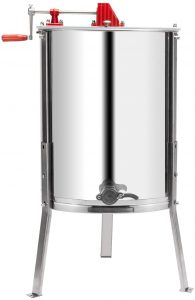
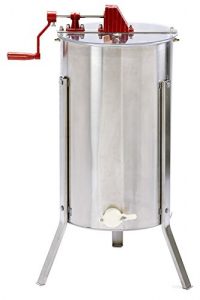
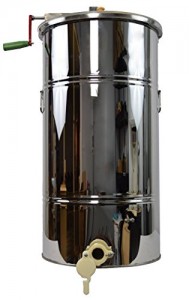
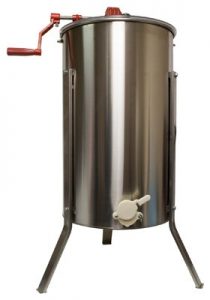
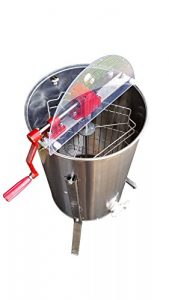
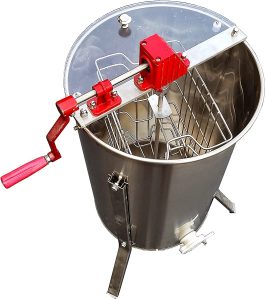
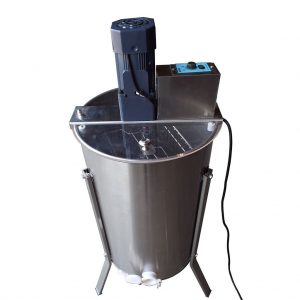
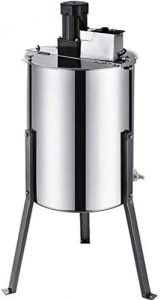
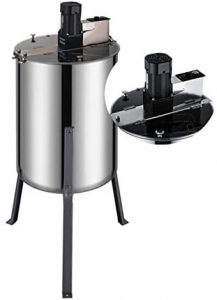
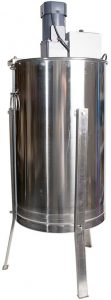
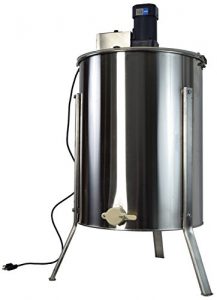
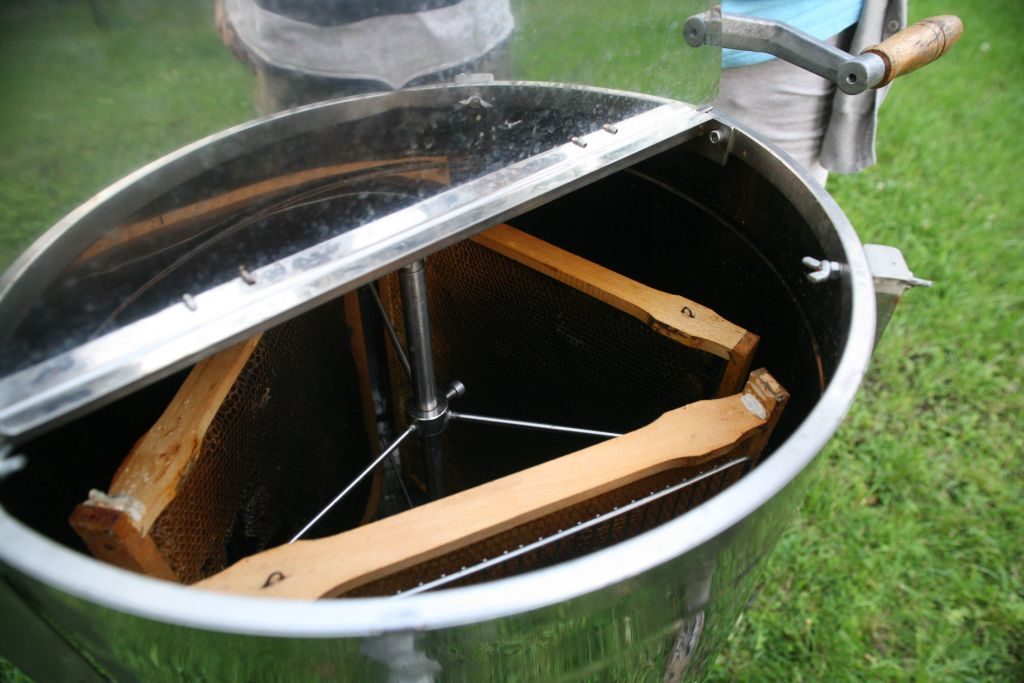
I purchased the 4/8 Frame Vivo that does both radial and tangential extraction. I found that the speed of the motor does not generate enough centripetal force to extract honey radially. Even tangentially, my yield of extraction is not great. It would be nice if the motor could rotate faster than then 100% setting. {any chance it’s adjustable inside the control box?}
Hello, it would be best if you contacted the manufacturer directly to resolve your issue – https://vivo-us.com/pages/support
What was the temperature of the honey. It’s kinda cold here in February and honey needs to be 85 F or higher to extract well.
The word is “spun” not “span.” Had to read everything three times just to get past that. But maybe just me.
Hi, thanks for pointing that out. It’s been corrected.
You are missing the high quality extractors. All the ones listed here are all “ok” but they are all about the same. These are homeowner duty and will break a lot. There are plastic parts in them that constantly break. Also, these are side honey gates and will allow some honey to remain. You never mentioned any Maxant equipment or anything. By the way, I built my own. I have a large hole on the bottom. My bottom plate is sloped to allow all honey to drain, and I have a heavy duty axle and bearings (thrust bearing at bottom).
Hi, thank you for your feedback.
When I see the absence of a brand that clearly should be addressed it makes me suspicious of the reviews. Particularly when there are “check price” buttons.
[…] honey with little or no impurities, and save the beekeeper a lot of time.The costs of buying a honey extractor are also […]
[…] beekeepers use honey extractors while others use less mechanization in the process. A honey extractor is sometimes expensive […]
[…] beekeepers use honey extractors while others use less mechanization in the process. A honey extractor is sometimes expensive […]
[…] to work with wood, metal and other materials. This honey extractor is used in beekeeping to extract honey from beehive frames. It is largely made of stainless steel. It can accommodate 2 beehive frames at […]
In shopping for extractors, American made Hillco is Radial and has a sloped bottom so you aren’t trying to scrape all the honey out ditting below the lip of valve, which can be a lot. Irritating.
[…] For a detailed list of the best honey extractors for your beekeeping operation, you can refer to this article by Beekeep Club. […]
[…] another tool to examine the colony; you need a tool to extract the honey. And when it comes to honey extraction, several steps are needed to be strictly followed to ensure that you’re getting the best results. […]
[…] extra work for the bees. The combs are the most valuable beekeeping resources. With technology, honey can now be extracted through highly efficient processes which include the use of centrifugal force. With using any […]